This handy Spectrum Math Grade 7 Answer Key Chapter 5 Lesson 5.3 Drawing Geometric Shapes: Triangles provides detailed answers for the workbook questions
Spectrum Math Grade 7 Chapter 5 Lesson 5.3 Drawing Geometric Shapes: Triangles Answers Key
When given two angle measures and one side length, a protractor and ruler can be used to create a triangle.
Draw a triangle that has angles of 30° and 80° and a side between them of two inches.
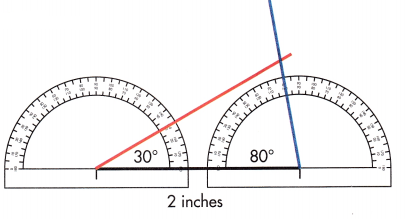
Step 1: Use a ruler to draw a line that is 2 inches.
Step 2: Use a protractor to draw a line that creates the desired angle with the first line (30°).
Step 3: Use the protractor to measure the 2nd known angle from the other end of your original line.
Step 4: Label the triangle.
Use the angles and side lengths given to create triangles. Label the measurements on your drawing.
Question 1.
a. angles: 50° and 55°
side: 1 inch
Answer:
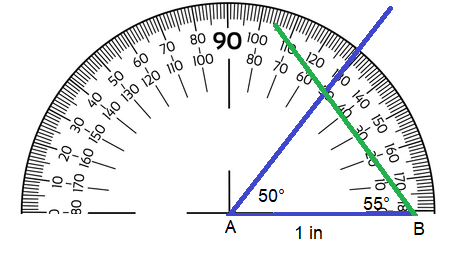
Explanation:
Step 1: Use a ruler to draw a line that is 1 inch.
Step 2: Use a protractor to draw a line that creates the desired angle with the first line (50°).
Step 3: Use the protractor to measure the 2nd known angle from the other end of your original line.
Step 4: Label the triangle.
b. angles: 120° and 30°
side: 2 cm
Answer:
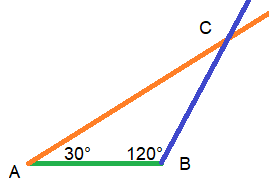
Explanation:
Step 1: Use a ruler to draw a line that is 2 cm.
Step 2: Use a protractor to draw a line that creates the desired angle with the first line (30°).
Step 3: Use the protractor to measure the 2nd known angle 120°from the other end of your original line.
Step 4: Label the triangle.
Question 2.
a. angles: 75° and 40°
side: 3 inches
Answer:
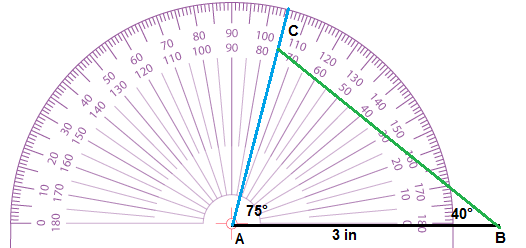
Explanation:
Step 1: Use a ruler to draw a line that is 1 inch.
Step 2: Use a protractor to draw a line that creates the desired angle with the first line (75°).
Step 3: Use the protractor to measure the 2nd known angle 40° from the other end of your original line.
Step 4: Label the triangle.
b. angles: 60° and 100°
side: 2 inches
Answer:
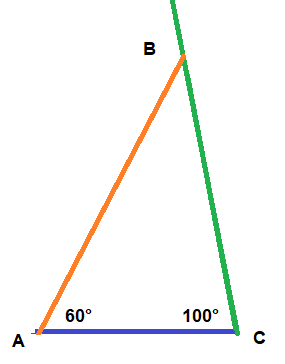
Explanation:
Step 1: Use a ruler to draw a line that is 2 in.
Step 2: Use a protractor to draw a line that creates the desired angle with the first line (60°).
Step 3: Use the protractor to measure the 2nd known angle 100°from the other end of your original line.
Step 4: Label the triangle.
When given the length of two sides and the measure of an angle that is not between the sides, a triangle can be drawn.
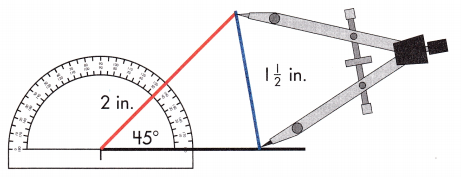
Draw a triangle that has sides of 2 inches and 1\(\frac{1}{2}\) inches and a non-included angle of 45°.
Step 1: Draw a line of any length.
Step 2: Use a protractor to draw a 2-inch line that creates the desired angle with the first line (45°).
Step 3: Use a compass set at 1\(\frac{1}{2}\) inches to find where the third line will intersect the base.
Step 4: Label the triangle.
Use the angles and side lengths given to create triangles. Label the measurements on your drawing.
Question 1.
a. angle: 50°
sides: 1 inch and 2 inches
Answer:
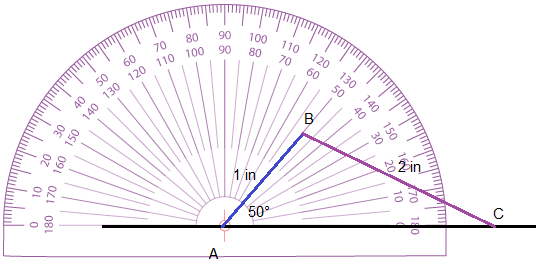
Explanation:
Draw a triangle that has sides of 1 inch and a non-included angle of 50°.
Step 1: Draw a line of any length.
Step 2: Use a protractor to draw a 1-inch line that creates the desired angle with the first line (50°).
Step 3: Use a compass set at 2 inches to find where the third line will intersect the base.
Step 4: Label the triangle ABC with angle at A.
b. angle: 140°
sides: 3 cm and 4 cm
Answer:
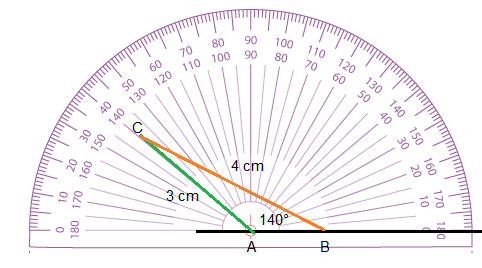
Explanation:
Draw a triangle that has sides of 1 inch and a non-included angle of 140°.
Step 1: Draw a line of any length.
Step 2: Use a protractor to draw a 3-inch line that creates the desired angle with the first line (140°).
Step 3: Use a compass set at 4 inches to find where the third line will intersect the base.
Step 4: Label the triangle ABC with angle at A.
Question 2.
a. angle: 85°
sides: 2 inches and 4 inches
Answer:
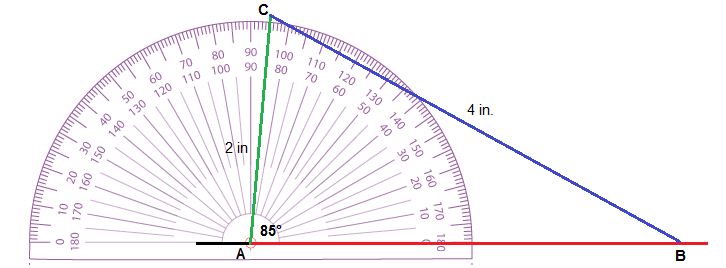
Explanation:
Draw a triangle that has sides of 2 inch and a non-included angle of 85°.
Step 1: Draw a line of any length.
Step 2: Use a protractor to draw a 2-inch line that creates the desired angle with the first line (85°).
Step 3: Use a compass set at 4 inches to find where the third line will intersect the base.
Step 4: Label the triangle ABC with angle at A.
b. angle: 100°
sides: 2 cm and 5 cm
Answer:
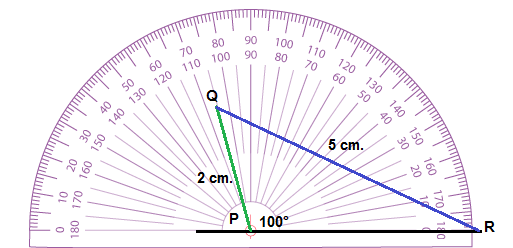
Explanation:
Draw a triangle that has sides of 2 cm. and a non-included angle of 100°.
Step 1: Draw a line of any length.
Step 2: Use a protractor to draw a 2 cm line that creates the desired angle with the first line (50°).
Step 3: Use a compass set at 5 cm to find where the third line will intersect the base.
Step 4: Label the triangle PQR.
When given the lengths of three line segments, determine if the segments make a triangle by examining their relationship. Each pair of sides added together must be greater than the remaining side.
a + b > c
a + c > b
b + c > a
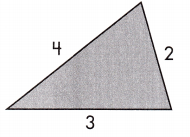
4 + 2 > 3
4 + 3 > 2
3 + 2 > 4
Because the measurements follow the rules, the side lengths make a triangle.
Using the given lengths, determine if they will make a triangle. Circle yes or no.
Question 1.
a. Side 1: 5 inches
Side 2: 3 inches
Side 3: 2 inches
yes
no
Answer:

Explanation:
Given a = 5, b = 3, c = 2
a + b > c
a + c > b
b + c > a
5 + 3 not greater then 2
5 + 2 not greater then 3
Because the measurements do not follow the rules, the side lengths can not make a triangle.
b. Side 1: 3 feet
Side 2: 8 feet
Side 3: 7 feet
yes
no
Answer:

Explanation:
Given a = 3, b = 8, c = 7
a + b > c
a + c > b
b + c > a
3 + 8 greater then 7
8 + 7 greater then 3
3 + 7 greater then 8
Because the measurements follow the rules, the side lengths make a triangle.
c. Side 1:10 inches
Side 2: 4 inches
Side 3: 12 inches
yes
no
Answer:

Explanation:
a + b > c
a + c > b
b + c > a
10 + 4 greater then 12
4 + 10 greater then 12
12 + 10 greater then 4
Because the measurements follow the rules, the side lengths make a triangle.
Question 2.
a. Side 1: 5 centimeters
Side 2: 8 centimeters
Side 3: 20 centimeters
yes
no
Answer:

Explanation:
a + b > c
a + c > b
b + c > a
5 + 8 not greater then 20
8 + 5 not greater then 20
Because the measurements do not follow the rules, the side lengths can not make a triangle.
b. Side 1: 5 meters
Side 2: 9 meters
Side 3: 20 meters
yes
no
Answer:

Explanation:
a + b > c
a + c > b
b + c > a
5 + 9 not greater then 20
9 + 5 not greater then 20
Because the measurements do not follow the rules, the side lengths can not make a triangle.
c. Side 1: 10 inches
Side 2: 10 inches
Side 3: 19 inches
yes
no
Answer:

Explanation:
a + b > c
a + c > b
b + c > a
10 + 10 greater then 19
10 + 10 greater then 19
10 + 19 greater then 10
Because the measurements follow the rules, the side lengths make a triangle.
Question 3.
a. Side 1: 4 millimeters
Side 2: 9 millimeters
Side 3: 9 millimeters
yes
no
Answer:

Explanation:
a + b > c
a + c > b
b + c > a
9 + 9 greater then 4
9 + 9 greater then 4
4 + 9 greater then 9
Because the measurements follow the rules, the side lengths make a triangle
b. Side 1: 4 inches
Side 2: 4 inches
Side 3: 7 inches
yes
no
Answer:

Explanation:
a + b > c
a + c > b
b + c > a
4 + 4 greater then 7
4 + 4 greater then 7
4 + 7 greater then 4
Because the measurements follow the rules, the side lengths make a triangle
c. Side 1: 7 centimeters
Side 2: 5 centimeters
Side 3: 14 centimeters
yes
no
Answer:

Explanation:
a + b > c
a + c > b
b + c > a
7 + 5 not greater then 14
5+ 7 not greater then 14
Because the measurements do not follow the rules, the side lengths can not make a triangle.
Question 4.
a. Side 1: 3 centimeters
Side 2: 3 centimeters
Side 3: 10 centimeters
yes
no
Answer:

Explanation:
a + b > c
a + c > b
b + c > a
3 + 3 not greater then 10
3 + 3 not greater then 10
Because the measurements do not follow the rules, the side lengths can not make a triangle.
b. Side 1: 4 yards
Side 2: 8 yards
Side 3: 6 yards
yes
no
Answer:

Explanation:
a + b > c
a + c > b
b + c > a
4 + 8 greater then 6
8 + 4 greater then 6
8 + 6 greater then 4
Because the measurements follow the rules, the side lengths make a triangle
c. Side 1: 2 meters
Side 2: 3 meters
Side 3: 4 meters
yes
no
Answer:

Explanation:
a + b > c
a + c > b
b + c > a
2+ 4 greater then 3
4 + 2 greater then 3
4 + 3 greater then 2
Because the measurements follow the rules, the side lengths make a triangle